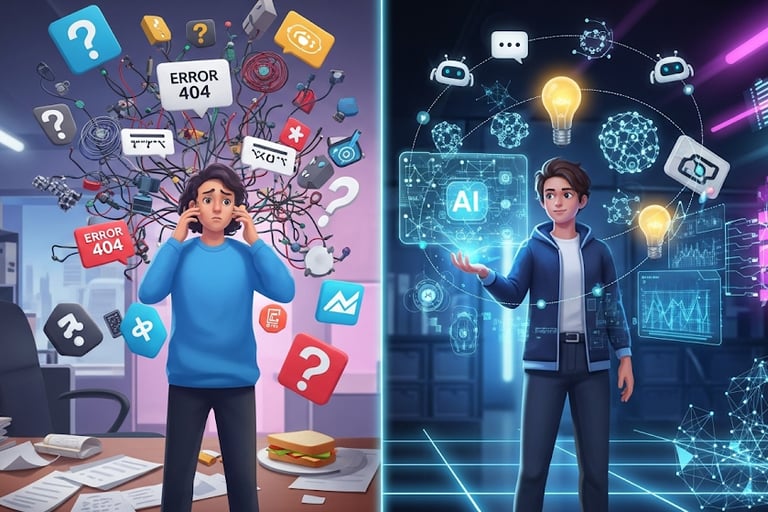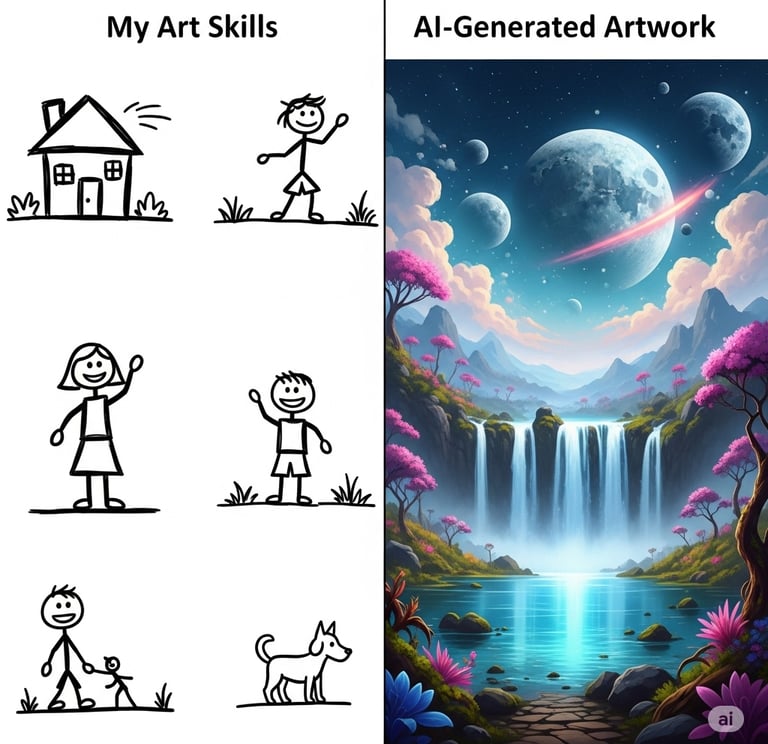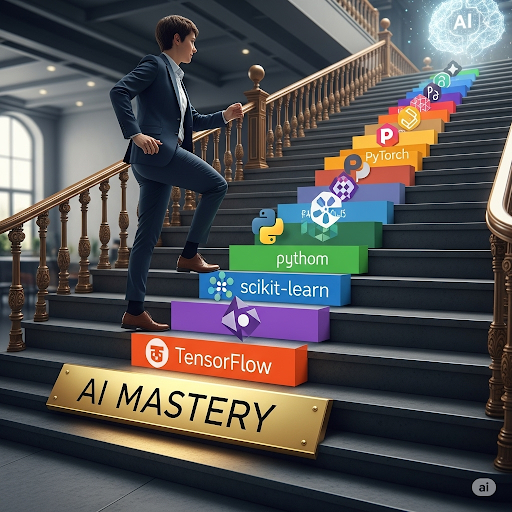How I Went from Tech Dummy to AI Wizard
Same as above lol
Solidarios, Bryan, Santiago
8/17/20256 min read
How I Went from Tech Dummy to AI Wizard (And You Can Too – No Coding Required!)
Introduction
Remember when using a computer meant knowing mysterious commands and praying you didn't accidentally delete everything? Well, AI tools today are the complete opposite. They're like having a super-smart friend who never gets annoyed when you ask "How do I...?" for the hundredth time.
I used to think AI was only for people who spoke in code and lived on energy drinks. Boy, was I wrong! Last month, I helped my neighbor create a professional presentation, write a compelling email, and even generate art for her small business – all using AI tools that require zero coding skills. If I can do it (trust me, I once called tech support because I couldn't find the "Any" key), you definitely can too.
Let's dive into the world of AI tools that are so user-friendly, even your technophobic uncle could master them.
The "I'm Not Tech-Savvy" Myth Needs to Die
Breaking Down the Biggest AI Misconception
Here's the truth bomb: modern AI tools are designed for regular people, not programming wizards. Think of them like smart microwaves – you don't need to understand electromagnetic radiation to heat your leftovers, right?
The biggest mistake people make is assuming they need technical skills to maximize AI potential. That's like saying you need to be a mechanic to drive a car. These tools are built with one goal: to make your life easier, not harder.
I recently watched my 70-year-old mom use ChatGPT to plan her entire vacation itinerary. She doesn't even know what HTML stands for, but she got better travel recommendations than most travel agents could provide!
The AI Toolbox Every Non-Techie Needs
Content Creation That Doesn't Suck
ChatGPT & Claude (That's me!): Your writing assistants that never judge your grammar
Write emails that get responses
Create social media posts that don't sound like corporate robots
Brainstorm ideas when your brain feels like mush
Translate "professional speak" into human language
Canva's AI Magic: Design like you went to art school
Generate logos that don't look like they were made in 1995
Create social media graphics without spending 3 hours on font selection
Turn text descriptions into actual visual designs
Real talk: I used Canva's AI to create my business cards, and people keep asking which expensive designer I hired. Plot twist – it was free and took 10 minutes!
Visual Content Without the Learning Curve
DALL-E & Midjourney: Your personal art department
Create custom images for presentations
Generate unique visuals for social media
Turn wild ideas into actual pictures
Pro tip: The secret to great AI art isn't technical wizardry – it's learning to describe what you want like you're talking to a friend who's good at drawing but has never seen what you're thinking about.
Productivity Tools That Boost Productivity
Notion AI: Your digital brain that remembers everything
Organize your thoughts without color-coding everything
Create to-do lists that you'll follow
Turn meeting notes into action plans
Grammarly's AI: Your editor who's always sober
Fix writing mistakes before your boss sees them
Make your emails sound professional without sounding like a robot
Suggest better ways to say what you're thinking
The "Start Here" Strategy for AI Newbies
Week 1: Dip Your Toes in the Water
Start with one AI tool for one specific task. Don't try to become an AI master overnight – that's like trying to learn guitar by immediately playing heavy metal solos.
Pick your biggest daily annoyance:
Hate writing emails? Start with ChatGPT or Claude
Struggle with presentations? Try Canva's AI features
Always forgetting things? Begin with Notion AI
Week 2-3: Build Your Confidence
Once you're comfortable with your first AI tool, add a second one. The key is consistency, not complexity. Use your chosen tools daily, even for small tasks.
I started using AI to write grocery lists (yes, really), and now I use it to create entire marketing campaigns. Baby steps lead to giant leaps!
Week 4 and Beyond: Become the AI Hero in Your Circle
Here's where the magic happens – you start seeing connections between different AI tools. Suddenly, you're the person everyone comes to for "How did you make this look so good?" answers.
Real-World Success Stories (AKA Proof This Works)
Sarah's Side Hustle Success
Sarah, a teacher with zero tech background, used AI tools to launch her tutoring business:
ChatGPT: Wrote her website copy and marketing emails
Canva AI: Created professional-looking flyers and social media posts
Grammarly: Polished all her client communications
Result? She went from "I don't know anything about marketing" to being fully booked in two months.
Mike's Career Pivot
Mike, an accountant who wanted to switch to marketing, used AI to bridge the knowledge gap:
Claude: Helped him understand marketing concepts and create a study plan
DALL-E: Generated visuals for his portfolio projects
Notion AI: Organized his job search and tracked applications
Six months later? He landed his dream marketing job, and his new boss was impressed by his "creative portfolio."
The Mistakes That Keep You Stuck (And How to Avoid Them)
Mistake #1: Waiting for the "Perfect" Tool
There is no perfect AI tool, just as there is no perfect car or perfect pizza. Start with what's available and learn as you go. The best AI tool is the one you use.
Mistake #2: Trying to Learn Everything at Once
AI tool overwhelm is a common challenge! Start by identifying one area of your life where AI could make a positive impact and concentrate on that. Take the time to master one tool before moving on to another.
Mistake #3: Expecting Magic Without Input
AI tools are incredibly smart, but they're not mind readers. The better your input (questions, prompts, descriptions), the better your results. Think of it like ordering at a restaurant – the more specific you are, the more likely you'll get exactly what you want.
Your 30-Day AI Transformation Plan
Days 1-10: Foundation Building
Choose your first AI tool based on your biggest pain point
Spend 15 minutes daily experimenting
Don't worry about being "good" at it – just show up consistently
Days 11-20: Skill Expansion
Add a second AI tool to your routine
Start combining tools (use ChatGPT to write content, then Canva to design it)
Join online communities to see how others use these tools
Days 21-30: Integration and Optimization
Use AI tools for real projects, not just practice
Share your results with friends (become the AI evangelist in your group!)
Start thinking about which tool to add next
Conclusion
Here's the beautiful truth about AI tools: they're not trying to replace you – they're trying to make you superhuman at the things you already do. Whether you're writing emails, creating presentations, or managing your daily chaos, there's an AI tool that can help without requiring a computer science degree.
The difference between people who successfully use AI and those who don't isn't technical skill – it's willingness to start before they feel ready. Every AI expert started exactly where you are right now: curious but clueless.
Your AI journey doesn't begin when you understand how neural networks function. It starts the moment you choose to explore something new and discover what unfolds.
Ready to Join the AI Revolution?
Stop waiting for the perfect moment to start using AI tools – that moment is right now! Pick one tool mentioned in this article and spend just 10 minutes exploring it today. Your future self (who's effortlessly creating amazing content while everyone else struggles) will thank you.














For any concerns, suggestions, feedback, please contact us at support@bryansolidarios.com
© 2025. All rights reserved.
